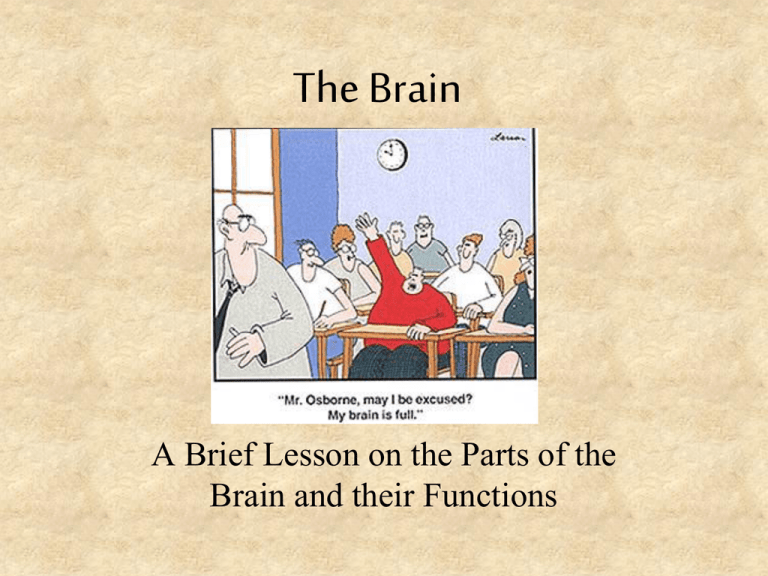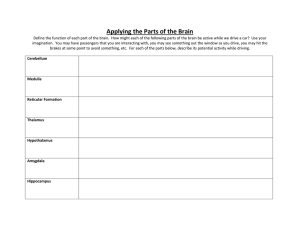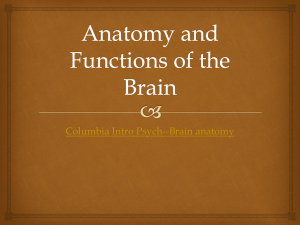Brain PowerPoint parts 1 & 2
advertisement

The Brain A Brief Lesson on the Parts of the Brain and their Functions Brain Stats • “the best organized, most functional three pounds of matter in the known universe.” • 100 million interconnected neurons • has the consistency of refrigerated butter • weighs 2% of our body weight • uses about 20% of our body’s energy • arterial blood from the heart goes to the brain first and the brain takes what it needs to survive. • http://www.youtube.com/watch?v=Li5nMsXg1Lk&feature=related Basic Parts of the Brain • Subcortical area (lower brain) – maintains the basic body functions • Cerebral Cortex (upper brain) – The outer layer of the brain that contains the four major lobes and the two hemispheres – 77% of our brain – Roughly the size of six 12”x18” sheets of construction paper Frontal Lobe Sensory Strip (Orange) Motor Strip Parietal Lobe (Blue) (Pink) Occipital Lobe (Red) Temporal Lobe (Green) Brain Stem The Lobes of the Human Brain • Frontal Lobe: Associates ideas, forms and plans activities, social control. • Parietal Lobe: Area that contains the Sensory Strip. Interprets physical sensation. • Occipital Lobe: Area that makes sense out of what we see. • Temporal Lobe: Area responsible for hearing and some speech functions. Also, memory (hippocampus) Motor Strip and Sensory Strip • Motor Strip: Band running down the side of the Frontal Lobe that controls all bodily movements. • Sensory Strip Band running down the side of the Parietal Lobe that registers and provides all sensation. The Motor Strip Three Brains in One… Three Brains Each of our brains can be divided into three parts: • Forebrain: Responsible for reasoning and logic • Midbrain: Relay Station between the Forebrain and the Hindbrain • Hindbrain: Basic life support functions and muscle coordination Cerebral Cortex Thalamus Hypothalamus Amygdala Hippocampus Reticular activating system Cerebellum Another Image of the Brain Other Parts of the Brain • • • • • • • • • • Cerebral Cortex – Upper Brain Limbic System Amygdala – Located in the Temporal Lobe Hippocampus – Located in the Temporal Lobe Thalamus Hypothalamus Pons Medulla or Brain Stem Cerebellum Reticular Activating System Forebrain Cerebral Cortex Limbic System Amygdala Hippocampus Thalamus Hypothalamus Cerebral Cortex • The “outer shell” or “upper brain.” • 1/8th inch thick. • Controls all mental processes and thought but will not keep the body running. • Contains over 100 billion neuron cells (2/3 of all the brains nerve cells). • Neurons connect to Axons which communicate with other parts of the brain. • Estimated that the number of connections between these nerves is greater than the number of particles in the universe. Limbic System • A group of brain structures involved with: – – – – Memory and motivation emotion Body function Smell • Contains the Amygdala and the Hippocampus Amygdala The amygdala is located within the temporal lobe and controls social and sexual behavior and other emotions like aggression & fear. Adds positive and negative feelings to long term memories for later use. The Amygdala is the size and shape of an almond Hippocampus The hippocampus is located within the temporal lobe and is important for learning long-term memory. Thalamus The Thalamus is the “relay station” of the nervous system: it sends incoming and outgoing messages between the brain and body. It relays all sensory information except that of smell The Thalamus is a pair and they are the size of golf balls Hypothalamus Regulates your basic needs, such as hunger and thirst, and emotions such as pleasure, fear, rage, and sexuality. If a person’s rage center is stimulated that person will go on a smashing spree The Hypothalamus is only the size of a large pea or a small cherry. Midbrain: Reticular Activating System The alertness control center that regulates the activity level of the body. It controls stimuli that travel from the body to the brain, regulating pain. Also controls sleepiness that comes from boredom. Hindbrain Pons Cerebellum Medulla Pons Named from the Latin word for ‘bridge’ Responsible for regulating sleep and relaying information from the brainstem (medulla) and the hindbrain Cerebellum The part of the brain that coordinates and organizes bodily movements for balance and accuracy. It looks like a ball of yarn a little larger than a golf ball. Medulla (Brain Stem) Responsible for breathing and heart rate Connects the nerve pathways between the brain and the body Damage to the Frontal Lobe Damage to the Frontal Lobe can cause: • Loss of simple movement of various body parts (Paralysis). • Inability to plan a sequence of complex movements needed to complete multi-stepped tasks, such as making coffee (Sequencing). • Loss of spontaneity in interacting with others. • Loss of flexibility in thinking. • Persistence of a single thought (Perseveration). • Inability to focus on task (Attending). • Mood changes and Changes in social behavior. Phineas Gage Explosive powders propelled a three and a half foot long iron rod into Phineas Gage's face. It pierced his left cheek, traveled behind his eye, and flew out the top of his skull. He didn't die. In fact, almost immediately after the accident, Gage could talk and walk. Before the accident, Gage had been a responsible, hard-working, fit and popular man. After the accident, Gage became a nasty, vulgar, irresponsible vagrant. His former employer, who regarded him as "the most efficient and capable foreman in their employ previous to his injury," refused to rehire him because he was so different. Damage to the Parietal Lobe Damage to the parietal lobe can cause: • Inability to attend to more than one object at a time. • Inability to name an object (Anomia). • Inability to locate the words for writing (Agraphia). • Problems with reading, drawing and math. • Difficulty in distinguishing left from right. • Lack of awareness of certain body parts and/or surrounding space (Apraxia) that leads to difficulties in self-care. • Inability to focus visual attention. • Difficulties with eye and hand coordination. Damage to the Occipital Lobe Damage to the Occipital Lobe can cause: • Defects in vision • Difficulty with locating objects in environment. • Difficulty with identifying colors • Production of hallucinations • Visual illusions - inaccurately seeing objects. • Word blindness - inability to recognize words. • Difficulty in recognizing drawn objects. • Inability to recognize the movement of an object • Difficulties with reading and writing. Damage to the Temporal Lobe Damage to the Temporal Lobe can cause: • Difficulty in recognizing faces (Prosopagnosia). • Difficulty in understanding spoken words • Disturbance with selective attention to what we see and hear. • Difficulty with identification of, and verbalization about objects. • Short-term memory loss. • Interference with long-term memory • Increased or decreased interest in sexual behavior. • Inability to catagorize objects • Right lobe damage can cause persistant talking. • Increased aggressive behavior. 2 Brains in 1 Right and Left Hemisphericity Brain Hemispheres • The Human Brain is divided into two hemispheres: Left and Right. • The two hemispheres are connected by a thick bundle of nerves called the Corpus Callosum. • Each hemisphere is responsible for different kinds of tasks, or kinds of thinking. • Research shows that most people prefer one side to the other and that this side is “dominant.” Left Brain The Left Hemisphere controls: • Muscles on the right side of the body • In most people the left side is dominant for language skills. • Left Brained thinking is considered to be: Logical, Sequential, Rational, Analytical, Objective, Looks at parts • Damage to the Left side will effect the Right side of the body. Right Brain The Right Hemisphere controls: • Muscles in the Left side of the body • Right Brained thinking is considered to be: Random, Intuitive, Holistic, Synthesizing, Subjective, Looks at wholes • Damage to the Right side will effect the Left side of the body. Split Brain Experiments • In the 1960s a popular “cure” for epilepsy was to cut the Corpus Callosum, separating the two brain hemispheres. • Once the brain was separated scientists could learn a lot about each, individual hemisphere. http://www.youtube.com/watch?v=ZMLzP1VCANo&feature=related Did you see a man or a woman? One way to determine brain hemisphere dominance… • One way that some people think you can determine brain hemisphere dominance is by studying the irises of the eyes. • Work with a partner to examine each others’ eyes • Use the images on the next two pages to figure out your brain dominance. A right-brain dominant Jewel structure notice there are more/larger/stronger brown dots (jewels) in the left iris indicating more activity in the right hemisphere. Right Eye Left Eye A right-brain dominant Flower structure notice there are more/larger/stronger fibre petals (flowers) in the left iris indicating more activity in the right hemisphere. A left-brain dominant Jewel structure notice there are more/larger/stronger jewels in the right iris indicating more activity in the left hemisphere. Right Eye Left Eye A left-brain dominant Flower structure notice there are more/larger/stronger flowers in the right iris indicating more activity in the left hemisphere.







